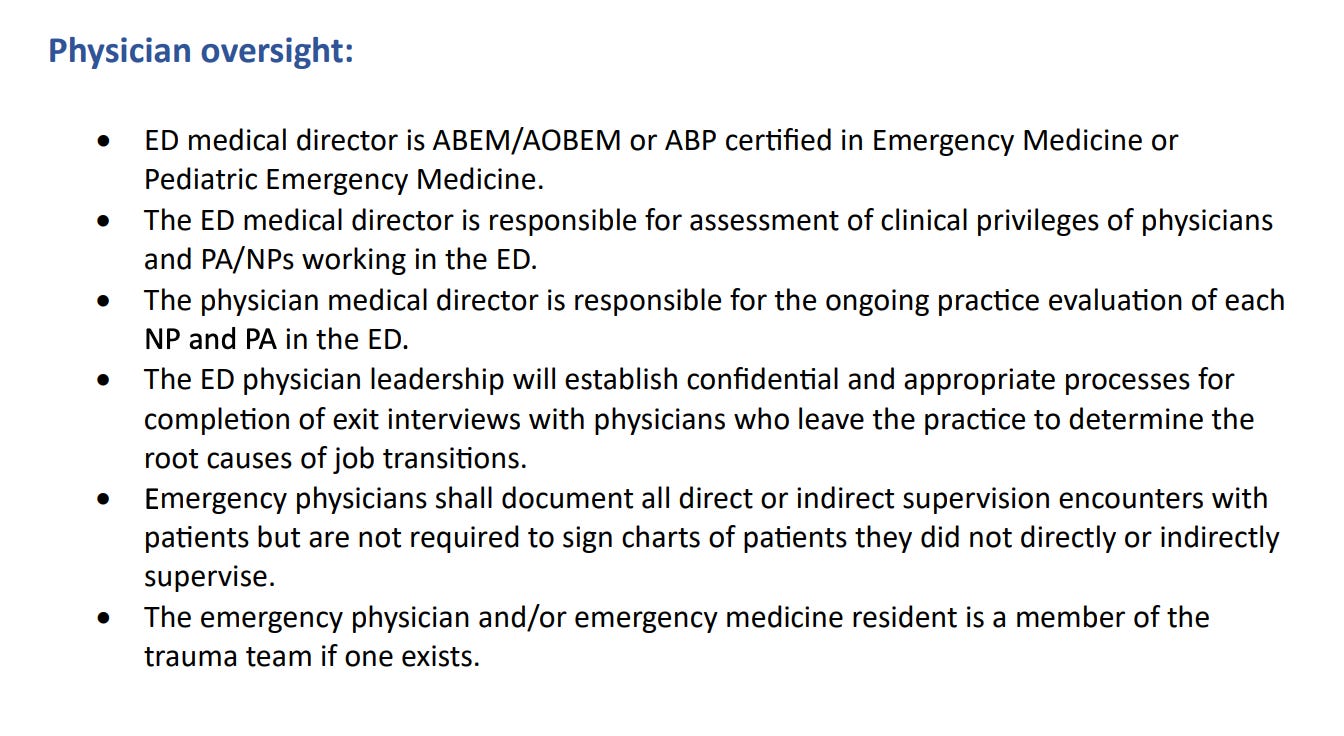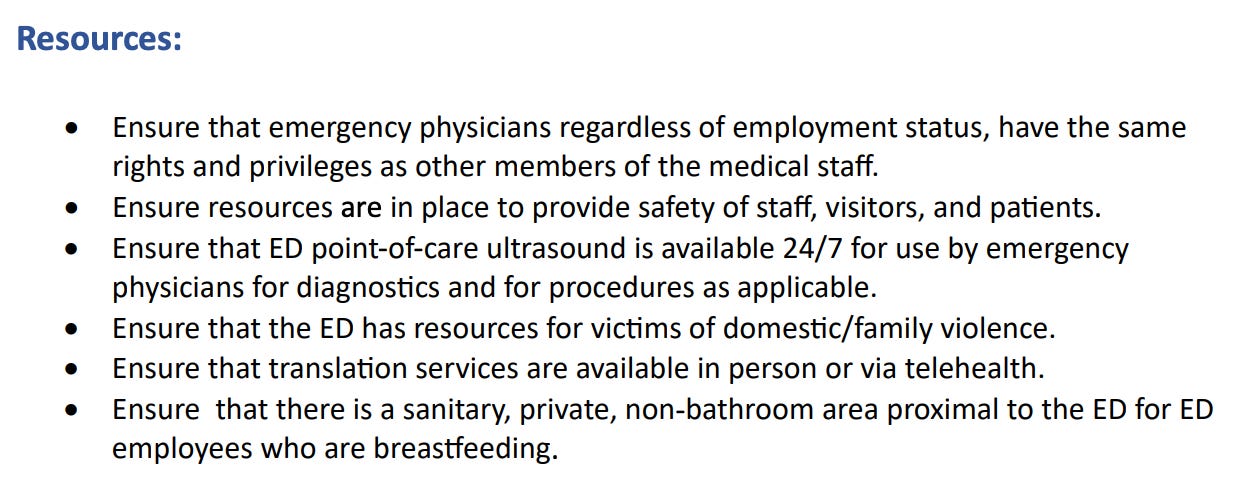ACEP ED Accreditation: The Small Print is a Big Deal (Part 1)
With accreditation, ACEP aims to turn its policies into action.
According to ACEP Past President Gillian Schmitz, MD on the Revitalizing Doctor podcast, ED Accreditation “could revolutionize emergency care.”
Schmitz continues, “How do we raise the bar? How do we improve patient care? How do we promote fair, productive working environments for emergency physicians? By implementing ACEP policies and evidence-based practices to improve patient care and standards for emergency medicine.”
ED Accreditation is ACEP’s attempt to turn its emergency medicine practice policies and guidelines into action at the ED level. Let’s dig into the details.
(Note: Due to the accreditation document’s detail, the EM Workforce Newsletter will tackle ED Accreditation in two stages. This article will focus on the sections headlined “to be met by all Emergency Departments seeking accreditation.”)
To qualify for any level of ED Accreditation - including for Critical Access and Rural Emergency Hospitals - an emergency department must meet all of the criteria listed in four single-spaced pages. ACEP is swinging for the fences.
Accreditation requirements are organized into the following sections: 1) Physician oversight, 2) Policies, 3) Quality, and 4) Resources.
The requirement for ED medical directors to be ABEM/AOBEM or American Board of Pediatrics certified in EM or PEM is a step toward further professionalizing emergency medicine. It would be hard to argue against board-certified surgeons leading Departments of Surgery or against board-certified cardiologists leading Departments of Cardiology. Why should emergency medicine be different from those specialties?
Not signing PA and nurse practitioner charts would be a major - and welcomed - practice change for many emergency physicians. Not requiring physicians to cosign charts seen solely by a PA agrees with the American Association of Physician Associates (AAPA) policy, which says, “Inflexible co-signature requirements diminish the quality and efficiency of care.”
The Society of Emergency Medicine PA’s policy on co-signatures: “There are three factors that can determine whether a PA's chart requires a co-signature: 1) State law; 2) Hospital Bylaws or regulations; 3) In some cases, requirements by third-party payers. The Centers for Medicare and Medicaid (CMS) program does not require PA documentation to have a co-signature.”
Most states do not require physicians to cosign all PA charts. According to the AMA, twenty states have some level of requirement for physician co-signature of PA charts.
Fred Wu, SEMPA’s Education Committee Chair, clarifies that “not co-signing a PA’s chart does not absolve the supervising physician of the legal obligation of PA supervision. If a lawsuit is filed, the supervising physician will likely also be named as a co-defendant. Collaboration will decrease risk and improve patient care.”
These accreditation policies include items that are consensus among emergency physicians, but have not yet been implemented by some hospitals. An example is the policy to “ensure that ABEM and AOBEM board-certified emergency physicians participating in continuing certification are not required to take additional life support courses.”
In 2017 all major EM organizations united to form the Coalition to Oppose Medical Merit Badges. They wrote, "The Coalition finds no rational justification to require medical merit badges for board-certified emergency physicians who maintain their board certification. Our committed professional organizations provide the best opportunities for continuous professional development, and medical merit badges dismiss the quality of those educational efforts." Any yet, many hospitals still require ACLS recertifications.
Some items are designed to give emergency physicians leverage when addressing common friction points between EM and other departments. For example: “Ensure that there is a hospital policy in place that supports timing of patient consults, including specified time periods from time of consult call to patient evaluation and from time of patient evaluation to provision of and care plan recommendations. These time intervals are collected and shared with consultants and included in the ED quality improvement plan.”
These quality items are smartly designed to empower emergency physicians when negotiating with hospital administrators. Emergency medicine tends to win when the focus is on improving patient care.
Pediatric readiness is such a major systemic problem among hospitals that the Wall Street Journal published a front-page article titled: “Children Are Dying in Ill-Prepared Emergency Rooms Across America — Hospitals and regulators have done little to ensure E.R.s are ready to treat children in emergencies, while researchers prove taking basic steps can save lives.”
Hospital administrators tend to follow their financial incentives. Pediatric care often does not generate enough revenue to get their attention. This accreditation requirement can help emergency physicians get the hospital funding and support needed for ED pediatric readiness.
The length of stay data collection requirement is a nice touch. In 2018, the Centers for Medicare and Medicaid Services (CMS) withdrew the requirement that hospitals track emergency department length of stay for admitted patients, a proxy for boarding times. Since then, ED boarding times have spiked. If the feds won’t track boarding times, ACEP can create a degree of hospital transparency through ED accreditation. “What gets measured gets managed.”
These resources are essential for any emergency medicine workplace.
The requirement that emergency physicians have the same level of hospital due process as other specialties has been a longstanding goal of the specialties’ leaders. Robert McNamara, MD, FAAEM defined due process as “a person will not lose rights without access to fair procedures. In the hospital setting, due process means clinicians will not lose their medical staff privileges without a fair hearing.” Per McNamara, “Physicians need due process rights at hospitals in order to fulfill their duty to serve as patient advocates.”
Female emergency physicians leave EM practice at an age more than a decade younger than their male peers. Lack of support for breastfeeding EPs is one factor that can be improved. A 2018 study showed that among breastfeeding physicians, “ninety-seven percent of women with breastfeeding experience reported at least one perceived barrier to successful breastfeeding.” Ensuring a sanitary, private, non-bathroom location for breastfeeding emergency physicians is an important step in the right direction.
In Part 2, we will explore the levels of ACEP ED Accreditation:
Gold / Level 1
Silver / Level 2
Bronze / Level 3
Rural
Blue Ribbon
Emergency Medicine Workforce Productions is sponsored by Ivy Clinicians - simplifying the emergency medicine job search through transparency.












Requirements need to be in the accreditation process that address EMS wall times. Patients held on EMS stretchers being cared for by medics in the ER is a risk to the ER, the EM Physician and the EMS agency. Much like stroke, cardiac and trauma, language will be needed to address EMS issues in the primary receiving point for the most critical patients.